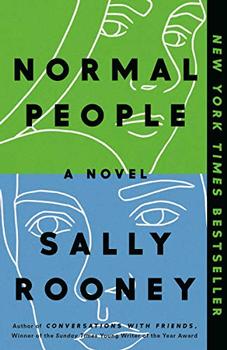Summary | Excerpt | Reading Guide | Reviews | Beyond the Book | Read-Alikes | Genres & Themes | Author Bio

This article relates to Normal People
 Two decades before I was born, a cousin of mine entered seminary and killed himself within the week. No one in the family discussed it. He was dead. No need to talk about why. But death by suicide has undergone a radical cultural shift. It is no longer absurdly kept secret.
Two decades before I was born, a cousin of mine entered seminary and killed himself within the week. No one in the family discussed it. He was dead. No need to talk about why. But death by suicide has undergone a radical cultural shift. It is no longer absurdly kept secret.
In Sally Rooney's Normal People, Connell fantasizes about killing himself. Despite being a fictional character, many young adults feel exactly as he does, unanchored and more alone than ever. Many enter into soulless relationships, or as they call them, situationships. They are on the same sports team or work in the same office and they hook up. Or they engage in Tinder, Grindr and other apps, which may satiate desire in the short term, but the loose connections leave many feeling desperate and lonely.
Data from the Center for Disease Control reveals suicide rates for teens spiked in the years from 2010 to 2015. During that time period smartphone use doubled. "We need to stop thinking of smartphones as harmless," Jean Twenge, San Diego State University psychologist and author of the book I-Gen cautions. Her research reveals that death by suicide increased 56% for 18- and 19-year-olds from 2008 to 2017. The number of teens who described themselves as "feeling nervous, helpless or that everything in life is an effort" rose 71%.
Pew Research has identified the social media sites young adults 18-24 years old frequent. 78% use Snapchat. 71% Instagram. 94% YouTube. When you shape those numbers around the fact that more young adults die from suicide than cancer, heart disease, AIDS, and strokes combined, it is clear that social media can be harmful for vulnerable users; those who are bullied online, shamed, and degraded; and those with a negative self-image.
When teens and young adults aged 14-24 were asked to rank social media platforms based on mental health, Instagram received the lowest score. The score was based on anxiety, depression, loneliness, body image, and bullying. Instagram is about creating an image. And once that image is public, it can trigger feelings of self-loathing and disgrace in the viewer. The image is so perfect. The person viewing it is not.
"Spending time on social media tends not to be in real time," Jean Twenge explains. "You're not having a real time conversation with someone. Usually you're not seeing their face and you're not giving them a hug; it's just not as emotionally fulfilling."
And so here we are at this sad irony. Young adult millennials are the most educated cohort the United States has ever produced. And yet they may be the most unhappy. Because suicide is often considered a family matter, boundaries and walls exist. But as suicides have become more public, so should the the conversation about it. We need to talk about it all – coping mechanisms, happiness, suicides that make the news, and mood changes to name a few. We aren't shy about saying to someone "you can't smoke in here," so why are we reluctant to ask, "you seem sad, what's going on?"
image from austincountynewsonline
Filed under Society and Politics
![]() This "beyond the book article" relates to Normal People. It originally ran in April 2019 and has been updated for the
February 2020 paperback edition.
Go to magazine.
This "beyond the book article" relates to Normal People. It originally ran in April 2019 and has been updated for the
February 2020 paperback edition.
Go to magazine.
Read the best books first...
Click Here to find out who said this, as well as discovering other famous literary quotes!
Your guide toexceptional books
BookBrowse seeks out and recommends the best in contemporary fiction and nonfiction—books that not only engage and entertain but also deepen our understanding of ourselves and the world around us.